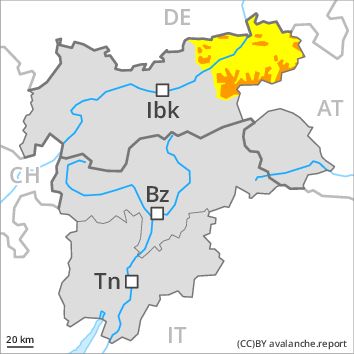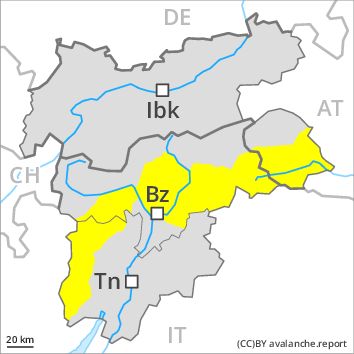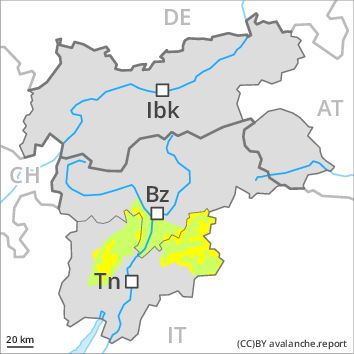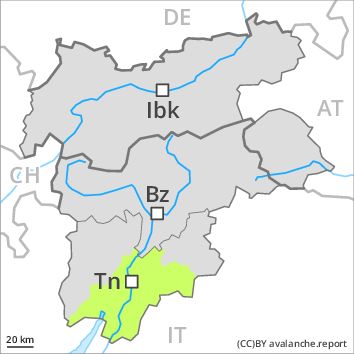Regions
Karwendel Mountains, Western Lechtal Alps, Central Lechtal Alps, Western Verwall Mountains, Eastern Verwall Mountains, Allgäu Alps, Silvretta, Samnaun Mountains, Eastern Lechtal Alps - Ammergau Alps, Mieming Mountains

Danger level
Danger Level 4 - High above the treeline
Danger Level 3 - Considerable above the treeline
Avalanche Problem
New snow above the treeline, N-NE-E-SE-S-SW-W-NW
Wind-drifted snow above the treeline, N-NE-E-SE-S-SW-W-NW

Outside marked and open pistes a very critical avalanche situation will persist, in particular in the regions exposed to heavier precipitation as well as in areas close to the tree line and in places that are protected from the wind above the tree line.
The backcountry and freeriding conditions are very critical. The fresh snow and wind slabs are prone to triggering, in particular in shady places that are protected from the wind above the tree line as well as in areas close to the tree line. Avalanches can in many places be released very easily and reach dangerously large size. More natural avalanches are possible. Fresh avalanches and whumpfing sounds and the formation of shooting cracks when stepping on the snowpack can indicate the danger. The danger exists primarily in alpine snow sports terrain. Avalanches capable of reaching valley bottoms and endangering exposed transportation routes are unlikely to occur.
Snowpack
dp 5: snowfall after a long period of cold
dp 6: cold, loose snow and wind
Over a wide area 40 cm of snow. fell. In particular in the Allgäu Alps, in the Western Lechtal Alps and in the Verwall Mountains 50 to 70 cm of snow. fell. The wind will be strong to storm force over a wide area. As a consequence of wind from northwesterly directions, extensive wind slabs will form in particular in places that are protected from the wind. Over a wide area fresh snow and wind slabs are lying on a weakly bonded old snowpack.
Faceted weak layers exist in the snowpack in particular on shady slopes. This applies especially in places that are protected from the wind in areas close to the tree line as well as on wind-protected west, north and east facing slopes above the tree line. In some places fresh snow and wind slabs are lying on surface hoar, in particular in places that are protected from the wind in areas close to the tree line.
Tendency
Outside marked and open pistes a critical avalanche situation will prevail. Friday: Significant warming to high altitudes.
Regions
Weißkugel Range, Val Müstair Alps, Gurgler Range, Langtaufers, Central Stubai Alps, Schnals Ridge, Northern Zillertal Alps, Southern Stubai Alps, Venediger Range, Southern Zillertal Alps and High Tauern, Northern Oetz and Stubai Alps, Western Tuxer Alps, Texel Mountains, Eastern Tuxer Alps, Glockturm Range, Grieskogel Mountains

Danger level
Danger Level 3 - Considerable
Avalanche Problem
New snow, N-NE-E-SE-S-SW-W-NW
Wind-drifted snow, N-NE-E-SE-S-SW-W-NW

Fresh snow and wind slabs in all aspects.
The backcountry and freeriding conditions remain critical. As a consequence of fresh snow and a strong to storm force northwesterly wind, extensive wind slabs formed in particular in the regions exposed to heavier precipitation. The fresh snow will be deposited on soft layers in particular on west to north to east facing aspects above the tree line. Fresh snow and wind slabs can in many places be released, even by a single winter sport participant and reach medium size. More small and, in isolated cases, medium-sized natural avalanches are possible. Whumpfing sounds and the formation of shooting cracks when stepping on the snowpack can indicate the danger.
Snowpack
dp 5: snowfall after a long period of cold
dp 6: cold, loose snow and wind
20 to 40 cm of snow, and even more in some localities, fell. The sometimes storm force wind has transported a lot of snow. The fresh snow and wind slabs will be deposited on soft layers, especially on wind-protected shady slopes above the tree line as well as in areas close to the tree line. The old snowpack will be subject to considerable local variations, in particular adjacent to ridgelines. In some places relatively hard layers of snow are lying on old snow containing large grains. In some places fresh snow and wind slabs are lying on surface hoar, in particular in places that are protected from the wind and in areas close to the tree line.
Tendency
Significant warming to the high Alpine regions. Outside marked and open pistes a critical avalanche situation will prevail.
Regions
Glockner Range, Western Pfunderer Mountains, Eastern Pfunderer Mountains, Durreck Range, Western Rieserferner Mountains, Ortler Range, Eastern Rieserferner Mountains, Saldurn-Mastaun Ridge

Danger level
Danger Level 3 - Considerable above 1800m
Danger Level 2 - Moderate above 1800m
Avalanche Problem
Wind-drifted snow above 1800m, N-NE-E-SE-S-SW-W-NW

Wind slabs require caution.
The backcountry and freeriding conditions are to some extent precarious. Caution and restraint are important.
As a consequence of fresh snow and a strong to storm force northwesterly wind, dangerous wind slabs formed in particular in the regions exposed to heavier precipitation. The fresh snow is lying on the unfavourable surface of an old snowpack in all aspects. Fresh snow and wind slabs can in many places be released very easily and reach medium size. Only isolated natural avalanches are possible.
Snowpack
dp 5: snowfall after a long period of cold
dp 6: cold, loose snow and wind
The snowpack will be subject to considerable local variations. In some places relatively hard layers of snow are lying on old snow containing large grains, in particular adjacent to ridgelines as well as on wind-loaded slopes. The sometimes storm force wind has transported the fresh snow and, in some cases, old snow as well. Caution is to be exercised in particular in places that are protected from the wind and in areas close to the tree line.
Tendency
Increase in danger of dry and moist avalanches as a consequence of warming.
Regions
Brandenberg Alps, Western Kitzbühel Alps, Wilder Kaiser Mountains - Waidring Alps, Eastern Kitzbühel Alps

Danger level
Danger Level 3 - Considerable above the treeline
Danger Level 2 - Moderate above the treeline
Avalanche Problem
New snow, N-NE-E-SE-S-SW-W-NW
Wind-drifted snow, N-NE-E-SE-S-SW-W-NW

Fresh snow and wind slabs in all aspects.
The backcountry and freeriding conditions remain critical, especially on shady slopes in areas close to the tree line as well as above the tree line. As a consequence of fresh snow and a strong to storm force northwesterly wind, extensive wind slabs formed. The fresh snow will be deposited on soft layers in particular on west to north to east facing aspects above the tree line. Fresh snow and wind slabs can in many places be released, even by a single winter sport participant and reach medium size.
Snowpack
dp 5: snowfall after a long period of cold
dp 6: cold, loose snow and wind
10 to 30 cm of snow. fell. The sometimes storm force wind has transported a lot of snow. The fresh snow and wind slabs will be deposited on soft layers, especially on wind-protected shady slopes above the tree line as well as in areas close to the tree line. The old snowpack will be subject to considerable local variations, in particular adjacent to ridgelines. In some places relatively hard layers of snow are lying on old snow containing large grains. In some places fresh snow and wind slabs are lying on surface hoar, in particular in places that are protected from the wind and in areas close to the tree line. Below the tree line a little snow is lying.
Tendency
Increase in danger as a consequence of warming.
Regions
Sexten Dolomites, Western Deferegger Alps, Ulten Valley, Gröden Dolomites, Southern Adamello, Eastern Deferegger Alps, Prags Dolomites, Sarntal Alps, Adamello - Presanella, Schober Mountains, Lienzer Dolomites, Sole, Pejo and Rabbi, Maddalene

Danger level
Danger Level 2 - Moderate
Avalanche Problem
Wind-drifted snow above the treeline, N-NE-E-SE-S-SW-W-NW

Fresh wind slabs require caution.
The fresh wind slabs can be released by a single winter sport participant in some cases in particular on steep shady slopes. They can be released in the weakly bonded old snow in particular in areas where the snow cover is rather shallow. In particular transitions from a shallow to a deep snowpack where weaknesses exist in the old snowpack are precarious. These places are clearly recognisable to the trained eye.
Snowpack
dp 5: snowfall after a long period of cold
dp 6: cold, loose snow and wind
5 to 10 cm of snow, but less in some localities, fell. The strong wind has transported the fresh snow and, in some cases, old snow as well. Especially above the tree line sometimes easily released wind slabs formed. The fresh snow and wind slabs of the last two days are lying on the unfavourable surface of an old snowpack in particular on shady slopes. Faceted weak layers exist in the old snowpack in particular here. At high altitudes and in high Alpine regions the avalanche prone locations are more prevalent.
Tendency
As a consequence of warming during the day and solar radiation dry and moist avalanches are possible.
Regions
Primiero - Pale di S. Martino, Northern Brenta - Peller, Western Nonsberg Alps, Southern Brenta, Fassa Valley, Northern Lagorai, Latemar, Eastern Nonsberger Alps, Northern Dolomites of Fiemme

Danger level
Danger Level 2 - Moderate above the treeline
Danger Level 1 - Low above the treeline
Avalanche Problem
Wind-drifted snow above the treeline, N-NE-E-SE-S-NW

Fresh wind slabs are to be evaluated with care and prudence.
In these regions the wind slabs have increased in size hardly at all. Mostly avalanches are only small but in some cases easily released. At high altitudes and in high Alpine regions avalanche prone locations are a little more prevalent. Adjacent to ridgelines avalanches can be triggered in deep layers of the snowpack and reach medium size in some cases. Restraint should be exercised because avalanches can sweep people along and give rise to falls. In steep terrain there is a danger of falling on the hard snow surface.
Snowpack
dp 6: cold, loose snow and wind
Up to 5 cm of snow, but less in some localities, fell above approximately 1200 m. The strong wind has transported the fresh and old snow. Especially above the tree line mostly small wind slabs formed. The fresh snow and wind slabs are lying on top of a weakly bonded old snowpack in particular on shady slopes. Faceted weak layers exist in the old snowpack in particular here.
Tendency
Wind slabs require caution.
Regions
Prealps, Cembra Valley, Bondone and Stivo, Vallarsa, Folgaria - Laverone, Southern Lagorai, Ledro Valley, Paganella, Marzola - Valsugana, Pine' - Mocheni Valley

Danger level
Danger Level 1 - Low
Avalanche Problem
Wind-drifted snow above the treeline, N-NE-E-SE-S-NW

Fresh wind slabs are to be evaluated with care and prudence.
In these regions the wind slabs have increased in size hardly at all. Mostly avalanches are only small but in some cases easily released. At high altitudes and in high Alpine regions avalanche prone locations are a little more prevalent. Adjacent to ridgelines avalanches can be triggered in deep layers of the snowpack and reach medium size in isolated cases. Restraint should be exercised because avalanches can sweep people along and give rise to falls. In steep terrain there is a danger of falling on the hard snow surface.
Snowpack
dp 6: cold, loose snow and wind
Over a wide area up to 5 cm of snow, but less in some localities, fell above approximately 1200 m. The strong wind has transported only a little snow. In particular adjacent to ridgelines and in pass areas mostly small wind slabs formed. The fresh snow and wind slabs are lying on top of a weakly bonded old snowpack in particular on shady slopes. Faceted weak layers exist in the old snowpack especially here.
Tendency
The conditions are mostly favourable for snow sport activities outside marked and open pistes. Wind slabs require caution.







